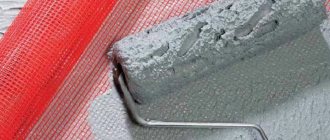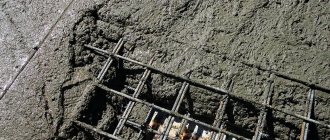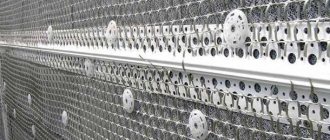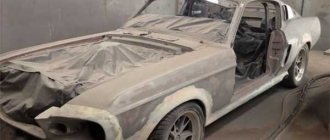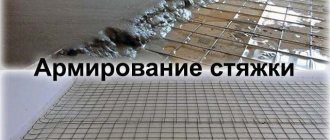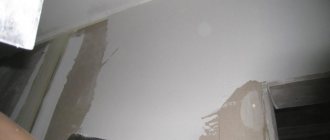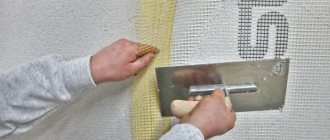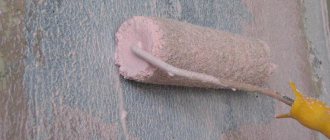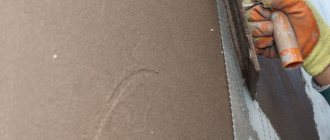What kind of technology
Reinforcement is an integral building material. Reinforcement strengthens structures and also extends their service life. When finishing structures, they often encounter defects that are difficult to hide. The only way out is to apply a thick layer of plaster. To ensure adhesion and strength of the coating, reinforcement is used.
It is recommended to use in cases where the coating layer exceeds 2 centimeters. Different materials are used for reinforcement. It is attached using the same technology. All that remains is to decide when it is better to use mesh for plastering walls, as well as which material to choose.
Why and when is it used?
Plaster mesh for interior work is used to solve various problems:
- Elimination of irregularities. After building a house, we are often faced with uneven structures. This is especially true when construction work is carried out by inexperienced specialists. To remove defects, plastering is carried out. If the layer is large, then you cannot do without reinforcement. Otherwise, the plaster will swell and peel off. The use of reinforcement will increase the strength of the coating.
- Increased adhesion to the structure. Compliance with all rules and regulations allows you to build structures that are even. Reinforcement with mesh for walls will ensure reliable adhesion of the cement-sand mortar.
- Repairing cracks. Plaster mesh allows you to eliminate cracks in the structure. The technology eliminates the emergence of new defects that negatively affect the strength and integrity of the coating.
Reinforcement with mesh for plastering walls is an integral process in creating a durable finish that will last for years.
Grid functions
Plaster reinforcement is a popular, effective, time-tested manipulation that significantly improves the technical characteristics of the finished coating. Without reinforcement, there is a high risk of the mortar peeling off from the surface of the walls, especially if it is applied in a sufficiently thick layer. If when facing concrete bases the adhesion with plaster is quite reliable, then when working with brick and wooden surfaces it is almost impossible to obtain a monolithic slab without reinforcement.
Application of mesh for plastering work
The mesh for plaster, which serves as a reinforcing fabric, performs the following functions:
- Makes it possible to level the walls with a more massive layer. This is often required when there are significant differences in the base or when using beacons.
- Ensures the integrity of the plaster layer and eliminates the risk of cracks even under conditions of high loads and vibration.
- Strengthens difficult areas that are prone to collapse, crumbling - above windows, doors, in corners and in other places that do not have support under the leveling layer.
- Increases the load-bearing capacity of plaster. The reinforcing mesh allows you to attach shelves, cornices, and decor without increasing the risk of coating detachment.
- Increases the service life of the coating. Rough and decorative finishing of walls after reinforcement will last an order of magnitude longer.
Reinforcing mesh increases the load-bearing capacity of the plaster layer
Professionals advise in any case to use reinforcement if the plaster is applied in a layer of more than 2-3 cm - this will help to avoid its delamination. The scope of application of reinforcing fabrics is not limited to internal work: they are also used to strengthen foundations, plinths, ceilings in the attic, between floors and for other purposes.
Advantages and disadvantages
The advantages of the mesh include:
- light weight, which allows it to be used on any structure, including light interior partitions;
- ease of installation - different elements are used for mounting on the wall;
- affordable price - depends on the material, as well as the manufacturer;
- easy processing - easy to cut into pieces, which simplifies finishing work;
- Convenient packaging - available in rolls, which simplifies finishing;
- withstands significant weight of cement-sand mortar.
Each type has operational characteristics. Plastic does not rust, which prevents the formation of red spots on the finish. Metal cells are highly durable. Often used for finishing facades and structures with a large area.
The features also concern the weaknesses of the material. Metal mesh is susceptible to corrosion. You need to work with them carefully. Do not leave it outdoors for long periods of time.
Polymer materials are characterized by low strength. It is not recommended to use for applying a thick layer of plaster.
Features of the chain link
The most popular of all metal analogues. Made from carbon, high-alloy or galvanized steel wire, which is often coated with a polymer. A product with PVC coating is more durable because it does not rust and can withstand environmental influences. Usually fences are made from chain-link.
It is made by twisting wire with a diameter of 1-3 mm into a spiral, from which the entire fabric is then woven. Chain-link is often used to cover adobe or clay walls before plastering them. The reinforcing relief layer that the mesh creates is capable of holding a lot of plaster. The thicker this layer, the larger the cells should be.
Types of reinforcing mesh for walls
The mesh for finishing work acts as a frame that holds the entire structure from destruction.
Before using reinforcement, other building materials were also tested. Experts wanted to get strength, high adhesion, elasticity and durability from them. However, not all options survived testing. Special requirements are imposed on materials that are used for exterior finishing, because... Temperature changes, moisture and other climatic factors have a negative impact on the surface.
The following meshes are most often used for plastering facades:
- metal;
- fiberglass;
- polyurethane;
- fiberglass;
- lavsan;
- from modified basalt glass (only for wooden surfaces).
Basalt
Basalt mesh has become widespread in the reinforcement of buildings made of foam blocks. Benefits include:
- low thermal conductivity;
- resistance to mechanical stress and chemicals;
- light weight;
- durability;
- environmental friendliness.
Basalt is not inferior in strength characteristics to metal reinforcement, but it is more durable and better resists corrosion.
Basalt mesh is more durable than metal mesh, because it is not subject to corrosion
Fiberglass
Fiberglass reinforcing mesh boasts all the performance characteristics of a plastic material. But unlike polymers, fiberglass exhibits chemical resistance, increased strength and higher tensile strength. The parameters of the fiberglass sheet largely depend on the size of the cells; also, to evaluate the characteristics of the mesh, the so-called density is used, which is measured in g/m2. Based on network density, they can be divided into three groups:
- Density within 50-160 g/m2. Suitable for work inside the house. Grids are divided into plaster and painting - the latter demonstrate lower density, and the standard cell sizes are respectively 2x2, 3x3, 2.5x2.5 mm. In plaster sheets, the cell size is significantly larger - the most popular options are 5x5 mm, the density of such a product is also higher.
- Density within 160-220 g/m2. – used for plastering and puttying on facade walls. The most common cell sizes are 5x5 and 10x10 mm.
- Density within 220-300 g/m2. – this mesh is used for the basement and underground part of the building. The use of reinforcement provides the finish with anti-vandal properties, since it is able to withstand severe mechanical and impact loads. Due to the larger amount of material used in the production of such materials, their price will also be higher.
In order not to be mistaken about the purpose of the mesh, it is worth understanding the rules for marking such material:
- C – network;
- CC – fiberglass sheet;
- N – exterior finishing;
- B – interior decoration;
- Ш – for painting work;
- A – base anti-vandal;
- U – with amplification.
Manufacturers indicate information about the technical characteristics of the material on the packaging.
In production, fiberglass mesh goes through the stage of increasing resistance to an alkaline environment, which is relevant for putty and plaster solutions. To prevent the fabric from dissolving in a weak or medium alkaline solution, the fiberglass is impregnated with a polyacrylic dispersion, which reduces the aggressive effects of an alkaline environment.
This mesh is sold in the form of a 1m wide sheet, sometimes the material is sold in the form of cut rectangles. The material is actively used for reinforcing seams, corners, etc.
Plastic reinforcing mesh
Modern polymer materials are very different from the first plastics. Thanks to this, not only massive products appeared, but also mesh ones that demonstrate high strength. This is how a new material appeared for reinforcing masonry and plaster coating. Polymer mesh fabric is made from polyurethane or polypropylene (for example, Plurim). In some qualities these materials are superior to metal ones.
For example, the advantages of plastic plastering mesh are as follows:
- no fastening to the base is required, since polymer materials are lightweight;
- light weight of rolls, ease of transportation;
- moisture resistance (no corrosion or rust stains);
- no rotting;
- environmental friendliness;
- resistance to vibration loads and elasticity;
- retain properties when temperatures drop to – 40°C or rise to + 100°C;
- lower price than metal and fiberglass products.
Flaws:
- some plastics are not resistant to chemical “aggressors”;
- A layer of solution thicker than 6-8 mm cannot be applied on top of a plastic mesh product.
Polyurethane mesh for plaster is inert to chemicals, therefore it is allowed for use in industrial buildings.
Products are distinguished according to two main parameters:
- shape and size of cells;
- degree of density (the maximum allowed load on the plaster coating depends on this value).
Polymer network meshes come in two configurations. For reinforcement, fabrics with cells are used:
- square shape (the letters PCF or SQ are indicated in the marking);
- diamond-shaped.
The latter are easier to manage when plastering is done alone. For interior work, mesh fabrics with 5 mm cells are used, for facade work - larger ones (from 10x10 mm).
In terms of density, products with values ranging from 70 to 165 g/sq.m. are universally used.
There is no need to attach the polymer mesh to the base with additional devices. It is enough to apply a layer of plaster or adhesive mortar to the wall, apply and straighten the canvas, running a spatula along the top with slight pressure, and “drown” the product into the layer. There should be no areas on the surface uncovered with the plaster mixture.
Serpyanka is the thinnest of the meshes. The scope of use is not limited to the cases already described. Serpyanka is used to cover the places where window and door blocks are attached to the wall.
Tapes vary in:
- material;
- weaving density;
- the presence of an adhesive layer (self-adhesive or without glue);
- strip width;
- place of use (indoors or outdoors).
Separate fastening of the serpyanka to the base is not required. It is applied to a layer of putty or plaster mixture, leveled with a spatula and, if necessary, an additional thin layer of composition is applied on top. Instead of serpyanka, fiberglass is sometimes used, the difference being that it does not have cells.
The tape, intended for interior work, has cells with a side of up to 4 mm. Serpyanka for facades has thicker threads and a cell size of 5 mm.
Metal
Metal facade mesh for plaster can strengthen not only the plaster layer, but also the walls themselves. This mesh is the most common option for finishing facades, plinths, and so on.
The choice of material is determined by its purpose, which determines the size of the cells, the thickness of the wire, and the method of fastening metal rods/wires:
- When plastering, a woven metal mesh is used, the structure of which resembles the structure of fabric, only metal wire is used instead of thread. The main characteristics of this material are small cells measuring from 1 to 2 mm or more. The wire used for the manufacture of such networks is protected from corrosion destruction, and therefore can be made of either stainless steel or carbon steel, but with protection from a layer of zinc or polymers.
- Chain-link is also considered in demand - due to its large cells, it creates a reinforcing relief layer that allows you to hold a thick layer of finishing material on the wall.
- Welded mesh made of wire rods welded to each other is also used to strengthen the masonry of walls, installation work, strengthening load-bearing surfaces, foundations, and so on.
- Masonry mesh is another version of a metal reinforcing material that is used for strengthening walls, plastering, pouring screeds, and so on.
- Plaster network made of metal is used exclusively for plastering. It is made from hot-dip galvanized wire, and therefore is not susceptible to corrosion.
Kinds
Reinforced elements are made from different materials:
- metal;
- fiberglass;
- plastic;
- nylon
Each type has strengths and weaknesses that should be taken into account when choosing.
Metal
It is used for plastering when the mortar layer exceeds 3 cm. If the layer is smaller, then it is recommended to choose plastic and fiberglass products. They are made using different technologies.
There are several types:
- woven - made from durable thin galvanized wire;
- wicker or chain-link mesh - woven mesh is movable, which allows it to be used with material that expands or contracts under the influence of weather conditions;
- welded - made of galvanized wire and used to strengthen the plaster layer;
- expanded metal – recommended for use when applying a small layer of cement-sand mortar.
When selecting cells for plastering, you should pay attention to the quality of the metal and the characteristics of the connection. For production, galvanized steel or polymer-coated wire should be used. This reduces the risk of corrosion.
Plastic
Often used for plastering walls made of aerated concrete and brick. The masonry fabric is made from durable polymers. It has different thickness and cell sizes. Plastic products are suitable for finishing external and internal walls. It resists temperature changes, moisture and corrosion well. It is inexpensive and does not require mounting. It is enough to glue it to the solution.
Nylon
Nylon thread is made from synthetic polyamide fiber. The material has high strength and other strengths. Reinforcing cells and other devices are made from it. Nylon products can withstand relatively heavy loads and resist negative environmental factors well. This explains the use for different purposes.
Fiberglass
Fiberglass mesh is superior to plastic mesh for stucco. It has high strength and easily withstands the negative effects of chemical and mechanical factors. Some types are impregnated with a composition that increases resistance to alkaline environments. Available in rolls, as well as in the form of corners, rectangles and tapes.
When considering fiberglass material, pay attention to the density. The scope of application of the canvas depends on it. For plastering interior walls, a material with a low density (up to 160 g/m2) is suitable. It is recommended to strengthen the base and underground structures of the building with dense fiberglass (220-300 g/m2). Density and purpose are indicated on the packaging, making selection easier.
How to choose the right mesh for wall reinforcement
The choice of material depends on various factors:
- composition of the plaster mixture;
- material of plastered structures;
- plaster thickness;
- operating conditions.
To reinforce cement-based plaster mortar, a mesh that is resistant to alkalis is selected. When using gypsum solutions, any reinforcing material will do.
It is not economically feasible to use heavy-duty, expensive imported reinforcing materials. It is better to opt for domestic meshes, which are not inferior in technical characteristics to foreign analogues.
Technology
This technology itself is not very new: in old houses, especially wooden ones, you can often find walls covered with a lattice of thin wooden planks, on top of which plaster has already been applied. Now the choice of materials is much richer; it is not limited solely to wood.
Problems solved by reinforcement:
- The adhesion of the plaster solution increases.
- The coating becomes stronger. Having hardened in a single layer, the plaster turns into a monolithic layer.
- This method helps to some extent correct the master’s flaws. Even with an ineptly applied mortar, the reinforcing mesh will hold the plaster, preventing it from crumbling (read what to do if the plaster begins to crack and crumble here).
Which one is best to use for plastering?
Reinforcing mesh is produced for a specific type of work. To determine the choice, there are several rules:
- A 3 cm layer of applied mortar should be made of fiberglass.
- Metal gratings are used when applying a solution with a thickness of 3 cm or more. When carrying out external work. And also for plastering baths and swimming pools.
- The plastic cell is designed for coating with gypsum solutions.
- Serpyanka and other tapes are used to reinforce plasterboard joints and cracks.
- Chain-link and fiberglass are used to finish the stove and fireplace. The first option is for cement-clay mortar, the second is for thin plaster.
These rules will help in choosing cellular fabric for certain jobs.
For interior work
For interior work, several types of mesh are used.
- Polymer material. Used for plastering surfaces with gypsum-based mixtures. A 2x2 cell will withstand gypsum mortar and will not crack the surface.
- Fiberglass. Mounted on a rough foundation made of brick or concrete. Holds cement mortar perfectly. It shrinks less, and when dry, cracks do not appear on the surface.
Attention. Using cellular fabric, the work goes quickly and easily. The surface is durable and has a long service life.
For outdoor
To work with outdoor surfaces, you need to choose the right mesh. To do this, follow the rules:
- the choice depends on the plaster used;
- dimensions of the surface on which the work will be carried out;
- thickness of the mortar layer applied to the walls;
- humidity, temperature changes.
Fiberglass cloth. Working with small square meters of facade surface.
Metal applicable:
- The wall area is large;
- a wall made of aerated concrete or brick, as well as wood;
- if there is high humidity or sudden changes in temperature;
- if the mortar used is cement-based;
- if increased strength is needed for the walls of the building.
Reinforcing metal is available in the following options:
- Chainlink.
- Welded type.
- Expanded metal mesh PVA;
- Solid drawn PVA.
I use different types of meshes for different jobs.
For the ceiling
Light nets are especially suitable for gypsum plaster ceilings. When thin-layer plastering, the threads of synthetic products overlap more easily, which reduces the consumption of plastering materials.
Often the ceiling in old-type houses is “decorated” with rustics - they are sealed with mortar with sickle reinforcement, or a mesh fabric is placed in accordance with their direction. The entire ceiling surface must be covered with canvas (the joints overlap by at least 10 cm). The corners of the junction of the wall and the ceiling plane are also reinforced with overlap.
Fastening the mesh using the correct technology
First you need to calculate the amount of canvas that will be required to complete the work. The method of fastening will depend on the type of base and the material itself. In any case, the cellular fabric must be secured strictly according to technology, avoiding strong tension or sagging.
Fastening the reinforced mesh
If lightweight products are easily fixed to the mortar by rubbing it in with a spatula, then thicker, more durable materials need to be fixed more securely. The operating procedure will be as follows:
- measure the required amount of material, carefully cut off a suitable piece;
- Secure it at the top with dowel nails, smooth out the corners and secure with self-tapping screws;
- repeat a similar operation from below, ensuring the optimal degree of tension;
- At the end of the work, attach the material in the middle so that it fits well to the rough base.
Installation of metal mesh under plaster
How to fix a product under a plaster base
Colored and other decorative fabrics are secured with simple self-tapping screws. At first, they are not completely screwed into the base at equal intervals according to the markings. Then put on the mesh and screw the screws into the wall completely. Sagging of the canvas must be completely eliminated! Small pieces of material or temporary coverings can be attached to the foam.
Fastening the mesh for drywall plaster
Coating with polymer sheets
Typically, such canvases are fixed with a mortar and a spatula. Cut the mesh into pieces of the required size, taking into account seam allowances. Apply a layer of plaster, carefully press a piece of material into it, and smooth it with a spatula. The fabric is overlapped so that one strip overlaps the other by 15–20 cm. If the walls have a complex configuration, the fastening is additionally reinforced with staples, screws or dowels.
Plastering walls with polymer canvas
Metal coatings
For a layer of plaster equal to 3–5 cm, a metal mesh is usually used. It weighs quite a lot, so it must be securely fastened. Before starting work, the canvas is degreased to remove dirt and lubricant residues. Traces of rust on carbon steel are treated with an anti-corrosion compound. Cut out pieces of the required size depending on the placement method (crosswise or lengthwise) using metal scissors or a grinder.
In the structure, holes with a diameter of 6 mm and a depth of 3 mm greater than the length of the dowels are drilled using a hammer drill. The approximate distance between the holes is made equal to 25 cm. The mesh is fixed to the wall with an overlap, starting from the top corner, and the edges are fixed with new dowels. The material is not pulled too tightly so that after plastering it can take an optimal position. Afterwards, the plaster is applied in several stages with intermediate drying of the layers.
Fastening the chain link to the wall
Technology of plastering walls on a grid
The technology itself is quite simple and if you have at least minimal experience, the process takes very little time. The main thing is to do everything in strict sequence in order to get a truly high-quality processing result.
Preparing the walls
First of all, it is necessary to prepare the surface of the walls for further treatment with plaster. Some may think that if a mesh is used, this stage can be skipped, but in fact this is not the case and preparation should never be skipped.
- First, the wall must be freed from the old coating. Everything is carefully removed so that the surface is perfectly clean.
- Then you need to try to remove the dust as efficiently as possible. If there is fungus or mold on the surface of the wall, each affected area is carefully treated using a special metal brush.
- Only after this can you begin to treat the walls with a primer. Due to this, the quality of grip will be several times better. The base will be more durable, and in the future the risk of mold, mildew or corrosion will be much less.
It is very important to approach this stage responsibly, because the final result will largely depend on how well the facade surface was prepared.
Why do you need a reinforcing façade mesh?
Finishing of facade walls is carried out using various materials and technologies. Reinforcing stack is used in two cases.
To improve the performance characteristics of the plaster layer. For such purposes, it is better to use a metal mesh made of galvanized wire.
Galvanized welded mesh
Reinforcement is recommended to be used on façade walls made of foam concrete blocks; no additional measures are required for brick walls.
All metal mesh
The fact is that among the many advantages of foam blocks, you must definitely pay attention to one very significant drawback - low physical strength. Another problem is that concrete blocks begin to crumble when they freeze/thaw under conditions of high specific humidity. As a result, the cement plaster begins to peel off with all the negative consequences.
Foam block plaster
The reinforcing mesh allows the plaster to adhere to the wall surface. Conversations that such a mesh should be used when the plaster is thick, and that this prevents cracks from appearing on the plaster, are only partially confirmed. Firstly, there are simpler and cheaper methods to prevent cracks from appearing in thick plaster. The simplest one is to spread the solution in a thin layer in several stages. Secondly, the adhesion of the mortar to the façade wall can be increased by slightly increasing the amount of cement in the mortar. If this is not enough, then spray it with cement laitance.
To protect façade wall insulation from damage. Reinforcing facade mesh is used during the finishing of foam insulation boards.
Plastering on foam plastic
Not to improve the fixation of glue to the surface of polystyrene foam and to prevent cracks, as some “sofa” builders write, but precisely for mechanical protection.
Reinforcement
Why do we say this? The surface of expanded polystyrene is protected from the negative effects of ultraviolet rays and, oddly enough, damage from birds. For some unknown reason, birds are very fond of pecking at polystyrene foam; if you leave it unprotected, many large and small depressions will soon appear on the surface. Conclusion - polystyrene foam needs to be covered. The cheapest and most reliable method is to use glue.
By the way, the advertising characteristics of manufacturers of plastic reinforcing mesh “they are not afraid of UV” do not in any way affect their actual performance indicators. The fact is that even the thinnest layer of glue or other cement-sand mixture does not completely transmit ultraviolet rays. Why should the consumer pay for features that he does not need? And one more nuance. Most often, builders fix the reinforcing mesh on the entire wall. We think that this is done either out of ignorance of the physical properties, or by the desire to earn more money. We recommend using reinforcing mesh to a height of 1.5–2.0 meters; there is no need to go higher. No one will damage the finish screed on the foam that high. Mechanical damage occurs due to various impacts, careless maintenance work near the facade wall, etc.
Methods for attaching different types of nets to walls
Each type of mesh that can be found on sale today has its own fastening features, which are very important to consider. Otherwise, the result will not please you, and the finish may soon begin to deteriorate.
Synthetic reinforcement products
In this situation, it is necessary to attach the material to the wall surface exclusively along the perimeter of the mesh. First, you need to securely secure the upper edge of the canvas using self-tapping screws, and then gradually attach all the other sides of the mesh used. There is no need to use any more additional products for fastening, because in the future the mesh will be secured as securely as possible using a layer of plaster.
As a rule, synthetic mesh is sold in rolls. To make installation take less time and require less effort, it is best to start fixing it along the wall parallel to the floor. You can start attaching the top part from absolutely any angle. It is worth paying attention to the fact that the joints must be overlapped with an overlap of up to 20 centimeters. Experts recommend cutting the canvas in such a way that a solid mesh is stretched over the entire wall. Due to this, it will be possible to increase the strength of the plaster layer several times.
Metal reinforcement products
In order to be able to work with metal materials, the additional use of self-tapping screws, construction dowels, and special metal mounting foam will be required.
All these materials should be prepared in advance.
- Before proceeding with installation, you need to cut the required piece of mesh. In this case, the builder must measure the area of the area on which he intends to apply plaster in the future. Metal scissors are used for cutting, because the mesh is made of a fairly thin material. If wire with a thickness of more than 2 mm was used for the mesh, then it can only be cut using a grinder. The canvas must be thoroughly degreased. To do this, a rag is moistened in a solvent, and then the surface of the mesh is wiped with it.
- The fastening in this situation will start from the ceiling. The top of the material must first be attached along its entire length using self-tapping screws. In this case, special cut pieces of polyurethane foam must be placed under the caps. You can also replace gaskets with wide washers, but the cost of such products is much higher than metal tape.
- When installing the mesh on a brick or concrete surface, you will need to make a certain number of holes in the wall into which plastic dowels will be inserted.
- The distance between the dowels used will depend on the exact thickness of the mesh used and the size of the cells. At the same time, experts recommend that the step width be no more than half a meter. In those places where the canvas is securely fixed, most often it is adjacent to the wall. In the case of those places that are between the fastenings, it should under no circumstances come into contact with the wall. Otherwise, the quality of the plaster layer will be several times worse.
- It is worth paying attention to the fact that at the joints the metal mesh must be installed with an overlap of up to 10 centimeters.
- If the canvas is fastened correctly, it will be very well stretched. If the mesh vibrates in some places, it means something was done incorrectly. Because of this, voids will form under the mesh, which will negatively affect the quality of the finish.
Metal mesh.
Metal mesh for plastering walls, as already mentioned, is used when it is necessary to make a layer of mortar of thirty millimeters or more.
It is better to choose galvanized steel with cells of ten by ten or twelve by twelve millimeters. An expanded metal mesh with a cell size of 10 by 25 millimeters is also suitable. Before starting to work with metal reinforcement, experts recommend degreasing it.
After this, they are cut with scissors into separate canvases, taking into account how they are planned to be placed on the surface of the wall or ceiling.
Then, using a hammer drill, holes are made for the fasteners. The distance between them is proposed to be chosen from 25 to 30 centimeters. Thus, you should get about sixteen holes per “square”.
The next step is to secure the metal mesh to reinforce the plaster with screws or dowels, or self-tapping screws (in the case of finishing a plasterboard surface). Additionally, the material is secured using mounting tape. The individual pieces should overlap each other by about ten millimeters. If necessary, drill additional holes for fastening - the reinforcement should not move away from the ceiling.
Then construction beacons are placed. Apply the first layer of mortar using a trowel. It is important to thoroughly push the solution through the cells. Then distribute it evenly over the entire surface. Wait until the layer dries before moving on to the next one.
In the process of plastering surfaces, professionals use a special mesh, thanks to the use of which many unique works of architecture have come down to us.
What is the mesh for?
Such systems are successfully used to reinforce the plaster layer. After installing a mesh of the desired type, a monolithic slab is formed on the surface that can withstand loads. Reinforcing mesh is a reliable option for strengthening the plaster layer. Its use makes it possible to form a strong and durable layer of material. Subsequently, you will not see cracks on it; the surface will remain smooth and of high quality for many years. This cannot be avoided if the finishing coating is applied directly to the surface of the wall or ceiling.
Over time, cracks will certainly appear, and the coating itself will fall off. It is a practical device that performs protective, heat and sound insulation functions. It will be required for the reliability and durability of rough finishing of walls, ceilings, and floors. It secures the leveling layer and prevents the mortar from not only cracking, but also peeling off. Plaster cannot lie perfectly on the selected surface; a mesh will help you with this. Once upon a time, wooden shingles were used for this; brick was plastered without preparation.
Plaster meshes can minimize the consequences of plastering, such as non-compliance with temperature levels, mortar proportions, and so on. The use of nets is necessary when the walls have defects and a thick layer of plaster is required. The mesh is not subject to corrosion, which eliminates the appearance of rust stains on the finish. It is convenient to work with because the design is light in weight.
Types of reinforcing mesh
Products differ from each other in operational capabilities, purpose and cost. There are many types of plaster mesh presented by manufacturers on the market.
Metal is necessary when performing interior decoration. It is offered with cells of different sizes. Manufactured from durable stainless or cold-rolled steel. Prevents finishing material from peeling due to its weight. Very convenient to use for work performed on the ceiling. The masonry is made from a special polymer. Its cells are not large in size - it is 5 by 5 mm. This mesh will be needed to work with a brick surface.
The universal one is made on the basis of polyurethane and is available in three types - small, medium and large. Divided into types depending on the size of the cells. Steel is made from rods by soldering them on structural units. The size of the cells in such a grid may vary.
Options for plastering walls
A very important stage in finishing the facade is directly plastering the surface of the walls. It is necessary to approach this process as responsibly as possible, because the final result largely depends on it. Plastering walls on a grid should be carried out in several stages. At each stage, one layer of the solution prepared in advance will be applied.
Experts recommend doing two, or better yet, three layers of plaster. It is worth choosing the number of layers taking into account what kind of surface will be processed. The very first layer of finish must be applied by “spraying”. That is why, when preparing the solution, it is worth remembering that its consistency should be similar to fairly liquid sour cream. When the solution is ready, it must be applied to the wall surface using a special trowel. It is worth noting that this can be done in any order, whichever will be most convenient in each individual case. Of course, the solution can be spread on the surface of the wall, but the first method will take much less time. Then the mixture is leveled using a spatula. The thickness of the first layer should not be more than one centimeter.
When the first layer is completely dry, you can begin the second stage of plastering the surface.
To do this, make a thicker solution that will resemble dough. It is applied to the walls using a trowel and then leveled using a rule. It must be pressed against the installed beacons and carefully inserted from the bottom up. This layer must completely cover the mesh that was used for reinforcement. When the solution has set well enough, it is necessary to carefully pull out the profiles, and carefully seal the grooves that remain after them with the solution.
The last stage is leveling the surface of the walls. To do this, a fairly liquid solution is made, which must be applied to the walls in a circular motion with a trowel and thoroughly rubbed over the surface.
Installation of beacons
In order to properly install the beacons, you will need to use a building level. It must be set so that the outer profile is in a vertical position. Then the profile needs to be secured using two self-tapping screws. After this, the lighthouse is fixed by using a small amount of gypsum mortar. Only after this can you begin to place a beacon on the other side of the wall. In order for all profiles to be in the same plane, a thread must be stretched between the outer guides. After this, you can install all other beacons. It is worth paying attention to the fact that they should be set so that the distance is less than the length of the rule used.
Selecting a grid
Despite the fact that the modern building materials market pleases us with a large assortment, oddly enough, this trend has not affected reinforcing mesh. Yes, you can find many brands under which these products are produced, but we will not advertise any of the manufacturing companies. Still, our article is not advertising. In construction stores we can only find:
- Metal mesh.
- Plastic mesh, which we talked a lot about in the previous section.
- Fiberglass mesh.
All. We don't need anything else. Now we will briefly characterize each of the listed subtypes of reinforcing mesh.
Metal reinforcing mesh
Used for surfaces with a significant degree of curvature (>.4 cm). This mesh tolerates being in an alkaline environment well, so you can safely use cement mixtures over it. If you plan to plaster with clay mortar, then this type of mesh will also suit you.
In the latter case, you should recommend using a mesh with cells whose size is 50x50 mm. It is recommended to reinforce monolithic walls of a garage or basement with a metal mesh.
Plastic reinforcing mesh
We already know quite a lot about her from the previous section of the article. We already know that it is used only (!) for gypsum mortar at the final stage of finishing the walls of the room. Therefore, it “will not survive” in an alkaline environment, which means it will be of little more than no use.
It usually costs less than metal ones. To work with it you need some experience and knowledge, since it is quite “capricious” and tends to sag. This is not surprising, because it is made of soft material.
Fiberglass reinforcement mesh
Now there is no point in going into details and describing in detail why such a grid is good (or bad). Let's just say that this is an alternative version of the previous plastic mesh, but this type is used only in cases where the thickness of the plaster layer is very small.
Meshes from popular manufacturers
The Italian concern Tenax produces mesh for plastering walls and other structures. In the product line:
- Armaflex is a biaxially oriented network made of polypropylene for plaster coatings with a thickness of 1-3 cm. Weight 100 g/m2. Withstands tensile load –
- Armatek – plastering fiberglass mesh. Density 110-138 g/m2.
- Polypropylene Sintaflex E can fully replace hardware in terms of strength. It is used for plastering walls up to 7 cm thick, reinforcing concrete screeds, and also for protection against moles.
- Plurima is a polypropylene product with small cells 5x5 mm. The area of the rolled fabric is 250 m2. Roll weight – 10.4 kg. Chemically resistant. Used for thin layers of decorative plaster and brickwork.
All products are universal, chemically inert, resistant to UV rays, and geometrically stable.
As for the plaster facade mesh sheets Valmiera, Alabuga, Bautex Eurofacade, Vertex, Textile Glass, they cannot be used inside the plaster layer, since they do not strengthen, but separate the plaster into two layers. They are used only by placing them inside a reinforcing layer of polymer glue, into which they are embedded.
Experience shows that the mesh for plaster is a very important element that helps prevent the appearance of cracks and destruction of the plaster layer under vibration loads and settlement of the building. It also protects facades covered with thermal insulation from destruction. The correct choice of reinforcing product and adherence to technology guarantee durability and long-term preservation of the appearance of the finish.
The rationality of using facade mesh under plaster
Plaster finishing is one of the most ancient types of facing work, which, like any other work technology, has not been spared by technical progress.
For example, less than a century ago, printed wooden shingles were used as a layer between the plaster and the wall surface, which today has been replaced by a more practical and functional facade mesh.
IMPORTANT!
Shingling is a frame made of thin wooden slats, stuffed in strict sequence . It is used to create a cellular convex base on the wall for further finishing.
The main functions performed by the façade mesh are:
- Reinforcement of the wall surface under the plaster mark;
- Additional hydro- and thermal insulation of the wall;
- Thanks to the strictly symmetrical arrangement of the threads, effective protection is achieved, preventing the formation of operational cracks and deformations in the finishing;
- The use of facade mesh allows you to create a more even layer of plaster;
- Serves as additional protection against external aggressive atmospheric influences on wall structures;
- The mesh reinforcing frame serves as a connecting link between the cladding and the wall , thanks to this material the solidity of the bond between the main structure and the plaster is achieved;
- Allows you to significantly extend the service life of facade plaster finishing.
Surface reinforcement
Question of price
The price of reinforcing mesh depends on the material, technical and operational parameters and manufacturer.
In different stores and construction markets, reinforced lattice of even the same type can vary significantly in cost.
To purchase the material at a favorable price for you, it is better to contact the manufacturer.
Average prices for 1m2:
- metal, made of galvanized wire Ø 0.25 mm - 470 rubles;
- welded galvanized, made of steel Ø 1mm - 250 rubles;
- fiberglass - 25 rubles;
- plastic - 20 rubles;
- polypropylene - 22 rubles;
- foam propylene - 65 rub.
You can take advantage of sales and seasonal discounts that large shopping centers offer at the end of the construction season.
Any reinforcing material is suitable for strengthening the plaster layer. The main thing is to choose the best option for your premises.
Why use mesh reinforcement?
Mesh reinforcement when plastering external walls is used in case of weak adhesion of the components of the finishing material with the main wall material (concrete, aerated concrete, brick or wood). In such cases, there is a possibility of peeling and crumbling of the plaster both some time after applying the solution and immediately. In addition, the mesh secures the rough leveling layer.
The need to use reinforcing mesh also arises during finishing work in a newly built building, when its walls are still shrinking. Deformations of the facade that occur during movements lead to the appearance of cracks and damage to the integrity of the finishing coating.
Reinforcing mesh when arranging a wall “pie”
Which mesh to use for plastering walls depends on the material of the walls, their relief, the degree of wear, the presence of external insulation, the structure and thickness of the layer of finishing materials, and finally, on climatic conditions. But with today’s wide range of products, reinforcing mesh for plastering walls must meet a number of requirements:
- ease;
- no additional loads on structural elements;
- resistance to aggressive chemical compounds and corrosion resistance;
- tensile strength combined with elasticity;
- resistance to various types of loads;
- density in the range of 150-170 g/m2 (to ensure strength and elasticity at the same time).
Wall insulation system “wet facade” using reinforcing mesh
Possible mistakes
Novice craftsmen often encounter mistakes that can lead to peeling of the solution and reduced surface quality:
- No primer. The primer increases the adhesion of the material. It must be used to ensure that the mortar adheres securely to the wall.
- Violation of proportions. Lack of water leads to increased density. Such plaster slides under its own weight and cracks.
- Adjustment of consistency with powder. The consistency of the working mixture should only be changed with water. To do this, it is administered in small portions, bringing it to the required volume.
- Refusal to reinforce joints and walls in new buildings. Joints made of different materials have different technical characteristics. They differ in behavior under changes in temperature and humidity. Therefore, cracks often appear at the joints. Reinforcement helps to avoid them.
- Incorrect position and fastening of the mesh. It is enough to secure the lightweight fabric around the perimeter. When using metal sheathing, fasteners are made over the entire area.
- Attaching beacons to a continuous layer. To install beacons, straps with a given pitch are used.
- Failure to comply with drying conditions. It is unacceptable to dry walls in direct sunlight, with a heat gun or at elevated temperatures. This leads to uneven drying of the mixture and cracking.
Drying the wall with a heat gun leads to uneven drying of the mixture and cracking. Frequent mistakes also include too thick a mixture, an excessively thick or thin application layer, and the use of low-quality materials.
Types of plaster mesh
Reinforcement products can be of different types and made of different materials depending on the application.
The most commonly used canvases are:
plastic masonry. It is used for brickwork, is made of polymer materials and has a cell size of 5x5 mm;
Plastic masonry grating.
universal small. Used for reinforcing thin layers in finishing plasters, made of polyurethane with a cell size of 6x6 mm;
Universal fine micro mesh.
- universal average. It has a cell size of 13x15 mm and is used for layers of medium thickness;
- universal large. Cell size 22x35 mm. Used for thick layers of plaster over large areas;
- fiberglass. This product is highly durable and resistant to temperature changes and chemical influences. It has a cell size of 5x5 mm (photo). The scope is not limited;
Cement plaster on fiberglass grating.
- armaflex. It is made of polypropylene with a cell size of 12x15 mm and has reinforced cell connection units. Used for plastered areas with heavy loads;
- steel mesh. Made from wire steel with different cell sizes. The product is used in places of high load during interior decoration;
- galvanized mesh, made of intertwined galvanized wire with automatic soldering at the plexus nodes. The product is particularly reliable, the scope of application is not limited, but its price is an order of magnitude higher than others.
Installation of fiberglass or propylene mesh
- To install the product, you need to apply the first layer of plaster or putty, then apply a mesh to the treated surface and slightly press it into the layer that has not yet hardened.
- After partial drying or immediately after installing the network, you can apply a second layer. The thickness of the layers must be distributed in such a way that the reinforcing fabric is located exactly in the middle of the entire thickness of the finishing layer.
Press the fiberglass grid into the mixture.
- You can often find this method when a propylene or fiberglass mesh is installed on the surface to be treated before applying plaster and secured with self-tapping screws or special metal staples. This method is acceptable for small coating thicknesses, where the total thickness does not exceed 10 mm.
- The ends of the reinforcing fabric in the internal or external corners are pressed tightly with a wide spatula or construction rule, at this time, the remaining parts of the fabric are smoothed with a small spatula or by hand.
We first fasten the network with self-tapping screws, then plaster it.
Installation of steel or galvanized mesh
To work with metal reinforcement you will need a tool such as:
hammer drill for making holes for dowels;
Electric hammer drill.
- trowel or ladle for throwing a layer of plaster;
- a large spatula or construction rule for leveling the surface;
- dowels with washers for fastening the reinforcing fabric;
- metal scissors for cutting mesh.
So:
- Metal sheets are used in cases where the coating of finishing plaster exceeds 30 cm or has a high load on the surface. Before starting work, the canvas must be degreased or wiped with a damp cloth.
- Next, the canvas is cut using metal scissors (photo) into small pieces for ease of installation. If there are seams in the floor slabs on the surface of the ceiling or floor, then the net is laid exactly on this seam.
Cut out the required piece with metal scissors.
- Using a hammer drill, holes for dowels are drilled in the surface to be treated at a distance of 20-35 centimeters from each other and the dowel tips are inserted. After this, sheets of canvas are placed on the surface and fixed with dowels with slight tension, preventing the mesh from sagging.
- Metal or plastic beacons are attached to the installed network strictly according to the level and given time to dry. The finishing solution can be applied in two stages depending on its thickness.
- The first layer is applied with a ladle or trowel, after which it is ironed well with force so that the solution passes through the mesh and does not leave voids.
- The second layer is applied after the first has completely dried and the surface is leveled according to the installed beacons using building rules. In most cases, the beacons are not removed, but are left in place to further strengthen the finish.
We install beacons and apply the mixture to them.
Recommendations from experts
It is possible to obtain a high-quality and reliable wall only if you follow advice from experts:
- Alignment. The walls should be carefully leveled. The level is checked using a plumb line or laser. The better the work is done, the better the finishing is.
- Taking into account the characteristics of materials. Compatible materials should be selected. Aggressive solutions are capable of dissolving the reinforcing structure.
- Taking into account the maximum load and possible shrinkage of the building. In the case of new buildings and facades that are severely deformed, it is recommended to use metal reinforcement.
- Final revision. Plaster is not a finishing coat. To give it decorative properties and prepare it for subsequent finishing, it requires sanding and sanding.
Experts recommend that you always sand the walls after applying plaster.
Reinforcing mesh is a necessary element for rough finishing of house facades and walls in new buildings. Its correct fastening and adherence to the technology of applying plaster allows you to create a reliable and strong coating that will last a long time.
Sources
- https://mirbetona.info/finishing/setka-pod-shtukaturku
- https://1beton.info/shtukaturka/setka-shtukaturnaya
- https://PoShtukaturke.ru/steny-vnutri/shtukaturka-vyravnivanie/oshtukaturivanie-sten-po-setke.html
- https://1pofasady.ru/shtukaturka/setka-dlya-shtukaturki-sten
- https://DekorShtukaturka.ru/instrumenty/setka-dlya-shtukaturki-sten
- https://oshtukaturke.ru/raznovidnosti/armiruyushhaya-setka
- https://arbolit.org/sovety/tehnologiya-vypolneniya-shtukaturki-po-setke.html
- https://1pofasady.ru/shtukaturka/tehnologiya-shtukaturki-fasada-po-setke
Why is plaster reinforcement needed, what function does it serve?
If you apply the mixture in the usual way, it will take a lot of time for pre-layer drying. Plaster on a mesh is applied faster, immediately over the entire thickness of the coating. The cells keep the composition stationary; they divide the common layer into many components. The strength of plaster on walls if a mesh is installed is much higher; it is not afraid of accidental impact loads. The mesh forms a monolithic slab.
The strength of plaster on walls if a mesh is installed is much higher; it is not afraid of accidental impact loads.
https://youtube.com/watch?v=eTyYGk_53Ps
